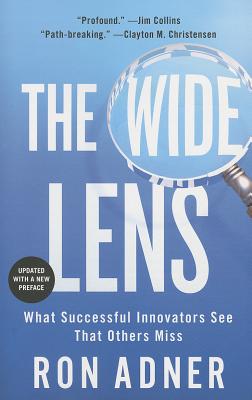Jack Covert Selects - The Wide Lens
February 09, 2012
The Wide Lens: A New Strategy for Innovation by Ron Adner, Portfolio, 231 pages, $29. 95, Hardcover, March, 2012, ISBN 9781591844600 Of all that’s been written and espoused on innovation over the past several years, it seems a key consideration has often been overlooked, one that Dartmouth College professor Ron Adner has gleaned from years of studying the subject. Adner has now detailed his findings as well as his prescription for greater success at innovation in The Wide Lens, in which cites many examples of companies that failed to check the “innovation blind spot” of their innovation ecosystem and consequently failed with innovations that should have been wild successes.
The Wide Lens: A New Strategy for Innovation by Ron Adner, Portfolio, 231 pages, $29.95, Hardcover, March, 2012, ISBN 9781591844600
Of all that's been written and espoused on innovation over the past several years, it seems a key consideration has often been overlooked, one that Dartmouth College professor Ron Adner has gleaned from years of studying the subject. Adner has now detailed his findings as well as his prescription for greater success at innovation in The Wide Lens, in which cites many examples of companies that failed to check the "innovation blind spot" of their innovation ecosystem and consequently failed with innovations that should have been wild successes.
In the case of Philips Electronics, the invention of HDTV in the mid 1980s was thwarted by a lack of television programing recorded in HD—cameras and even a broadcasting standard were not yet in place. Sony had a similar blind spot when it developed the first e-reader, only to realize that e-books were not yet readily available for purchase. Ditto Johnson Controls, which developed a new generation of electrical switches and sensors to dramatically reduce energy use in buildings. The blind spot in its ecosystem was a lack of architects, electricians and others willing to adjust their routines in order to specify the new money-saving technology.
Adner writes:
Welcome to the world of innovation ecosystems—a world in which the success of a value proposition depends on creating an alignment of partners who must work together in order to transform a winning idea to a market success. A world in which failing to expand your focus to include your entire ecosystem will set you up for failure. Avoidable failure.Through more than 10 years of study, Adner has developed blueprints and systems to assess a company's innovation blind spots, its innovation ecosystem, and its odds of success. The most effective way to set a wider lens, according to Adner, is to create what he calls a Value Blueprint, which identifies the players and intermediaries, clarifies the project and identifies risks and ways to assess and move around those risks. Though Adner acknowledges there will be unseen challenges and unknowns, the Value Blueprint will help take the foreseeable challenges out of a project's execution.
The Wide Lens opens the readers' eyes to the bigger picture and expands the mind to the possible pitfalls that have come to stand in the way of the success of many innovative products and services, including vehicle tires that can be safely driven on after a blowout, the electric car, and inhalable insulin. Had a wider lens been employed at the time of the creation of these valuable innovations, the world might be a better place. Don't miss out on your opportunity to see your innovation go from conception to success by engaging a wider lens.



